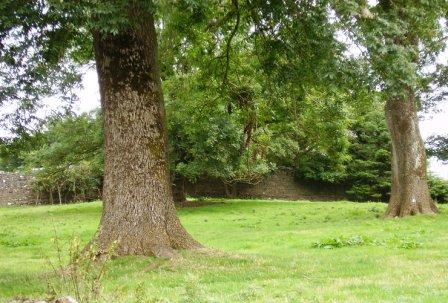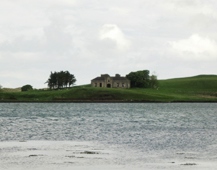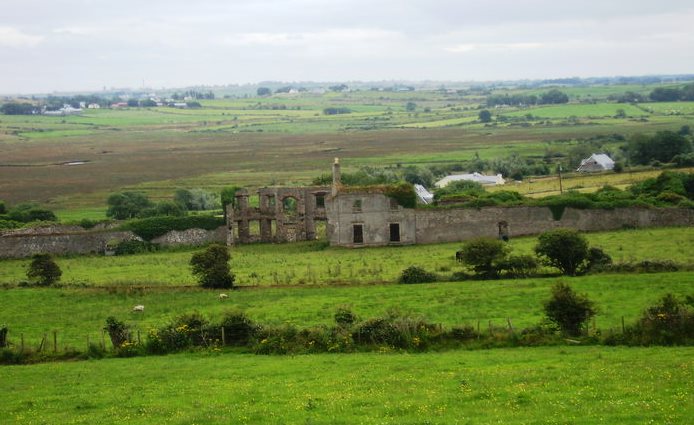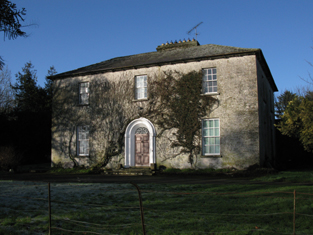Rathfranpark
Houses within 10km of this house
Displaying 29 houses.
Houses within 10km of Rathfranpark
Displaying 29 houses.
| House name | Description | |
|---|---|---|
| Killala Castle | Formerly the residence of the Protestant Bishop of Killala and Achonry, it was occupied by Walter James Bourke and his wife, daughter of the Hon Frederick Cavendish founder of the ''Connaught Telegraph''. The castle was severly damaged by the 'Big Wind' in January 1839. Demolished in the 1950s. | |
| Heathfield | Rev. William Bourke was leasing Heathfield from the Palmer estate at the time of Griffith's Valuation when it was valued at £16. Slater notes Heathfield House as the seat of Major W.H. Bourke in 1894. In 1927 the Bourkes moved to county Meath and the house was sold to the Brices, who owned it until 1932. Some ruins of the original house remain. | |
| Crosspatrick | The Ordnance Survey Name Books refer to the building of a house in 1832, the residence of James Knox who held the townland from Mary Boyd. At the time of Griffith's Valuation the house was occupied by William Kirkwood. Some floor tiles, which remain in the present farmyard at Crosspatrick, indicate the site of the house which no longer exists. |

|
| Ballintober | At the time of Griffith's Valuation, this property was held in fee by Nicholas Handy and valued at £8. The house is no longer extant but it was positioned behind the present house, where the red corrugated roofed building now stands. |

|
| Rosserk | Captain Green resided here in the 1830s. At the time of Griffith's Valuation, Capt Augustus Bolton was occupying a property valued at £10. On the 25-inch Ordnance Survey map of the 1890s a different building, adjacent to a large corn mill and located at G243252, is labelled Rosserk House. Buildings are still extant at this site. | |
| Ballykinlettragh | At the time of Griffith's Valuation, Henry "Faucett" had much of this townland leased from the Binghams of Bingham's Castle, barony of Erris. A building labelled Ballykinletteragh House appears on the 1st edition Ordnance Survey map but has disappeared by the publication of the 25-inch edition in the 1890s. | |
| Ballinglen Cottage | Leased from the Knoxes of Castlereagh, barony of Tirawley. At the time of Griffith's Valuation John Fawcett occupied property in this townland including a house valued at £12 and a mill. Occupied by Susan Pringle in 1906. Ballinglen Cottage is now in ruins. | |
| Farmhill | Built in 1780 this house became the principal seat of the Gardiner family. It was left by Harriet Gardiner to Susan Pringle who died in 1910. Farmhill then became the parochial house until the 1950s when it was demolished. Only the large walled garden now remains. | |
| Tonroe | Another Gardiner house in the parish of Rathreagh. At the time of the Ordnance Survey in the 1830s it was described as being in bad repair and occupied by a herd. P Ruane described the dilapidated state of the house in the mid 1990s but writes that the setting was very attractive. | |
| Courthill | The house was built in 1768. In 1786 Wilson refers to "Ranadyff" which may be this property, as a seat of Mr. Gardiner. At the time of Griffith's Valuation the occupier was Lacklin Chisholm. Frank Boland had a racing stable at Courthill in the 1940s and trained a horse named 'Lough Conn', who came second in the Aintree Grand National of 1947. |

|
| Springhill | Springhill was occupied by Francis Goodwin in 1814 and by Thomas Goodwin in 1837. By the time of Griffith's Valuation Bartholomew Donohoe was leasing the townland from the Palmer estate but the buildings were only valued at 10s. Springhill is labelled as "in ruins on the 25-inch map of the 1890s and there is no trace of it now. | |
| Broadlands | The home of the Knox Gore family, let to Patrick C Howley in the 1830s. It was leased by John Knox, of the Rappa Castle family, at the time of Griffith's Valuation when the house was valued at £15 10s. . A house is still extant at this site. | |
| Bartragh House | A Kirkwood family home in the 19th century. At the time of Griffith's Valuation, the property was leased by William Hopper from the Kirkwood estate when the buildings were valued at £16. A house is still extant at the site though in a dilapidated state. |

|
| Castlereagh | Described by Wilson in 1786 as "the fine seat of Mr. Knox" this house was badly damaged in 1798 and a new one subsequently built. There is a lithograph of the house included in the Encumbered Estates' Court sale rental. It was bought by Arthur E. Knox's brother Ernest Knox. In 1894 it was the residence of John V. Knox. The house has been demolished but portions of the walled garden remain. |

|
| Palmerstown | In 1786 Wilson had noted Palmers Town as the seat of Mr. Palmer. The original Palmer house is marked "in ruins" on the first Ordnance Survey map of the late 1830s. The Irish Tourist Association File states that it was destroyed by fire when the French forces passed by in 1798. In the mid 19th century Henry A Knox, fifth son of Annesley G Knox of Rappa, leased the townland from Sir William Palmer. Knox lived in a house converted from part of the yard buildings of the original house before the mid 1850s. His descendants continue to live there today. |

|
| Netley House | The home of Henry William Knox, fourth son of Francis Knox of Rappa, occupied by Richard Burke at the time of Griffith's Valuation when the house was valued at £30.. The house is now a ruin. |

|
| Castle Lackan | Wilson refers to Castle Lackan as" the fine seat" of Sir R. Palmer in 1786. It was occupied by James Cuff, Lord Tyrawley, early in the 19th century and later by his daughter and son-in-law, Jane and Charles Knox. It was held in fee by Colonel Charles Knox at the time of Griffith's Valuation, when it was valued at £50. It is now a ruin. |

|
| Moyne Abbey | Associated with the Lindsey family in the 17th century it was leased to the Knoxes by James O'Hara, Lord Tyrawley, for 999 years in 1741. The Knoxes built a private residence on to the east end of the friary. At various time the Jones, Palmer and Kirkwood families leased parts of Moyne. Thomas Jones sold his interest in the Landed Estates' Court in 1867. The Ordnance Survey Name Books record that Peter Nolan, agent to Sir William Palmer, lived in a neat cottage in the east of the townland. This may be the property labelled Moyne House on the 25-inch Ordnance Survey map of the 1890s (G228287), the remains of which are still extant. | |
| Belville | An Orme home in the first half of the 19th century. Described in 1942 by the Irish Tourist Association surveyor as a large house near the church at Ballyglass, formerly owned by the Orme family and "purchased some years ago by Mr MacDonald, Kilfian. It has remained unoccupied...", due to a popular belief among the local people that the house was haunted. It is no longer extant. | |
| Summerhill | An 18th century house, home of the Palmer family. Wilson refers to it as the seat of Thomas Palmer in 1786. Blake records that it was leased to John Bourke at the time of the 1798 rebellion. At the time of Griffith's Valuation, it was occupied by Thomas Palmer, leasing from Ernest Knox, and valued at £15. Later sold by the Palmers to the McCormack family who owned it until the 1920s. it is now a ruin. |

|
| Fahy | Built 1796, a former Paget home occupied by Ernest Knox of the Castlereagh family in the late 1830s. Lackland Chisholm was the tenant at Fahy in 1853. The original house is no longer extant. | |
| Ballybroony | An 18th century house, occupied by Fallon in the late 1770s and in 1786. The residence of the Perkins family from the early 19th century. It was held by Arthur Perkins from the Earl of Arran at the time of Griffith's Valuation when it was valued at £17. Lived in until the early 21st century and for sale in 2006. Restoration work was underway in 2010. |

|
| Lissadrone | Described at the time of the first Ordnance Survey as a plain building ornamented with a few trees and shrubs and held on a lease for ever. In the 1850s it was occupied by Matthew Flynn and is now a ruin. | |
| Smithstown House | Ruane writes that the house was built by the Palmers and became a Royal Irish Constabulary barracks. It was the home of the Pugh family in the 1830s. The only building in the townland at the time of Griffith's Valuation, of more than £2 valuation, was the barracks. Sold in 1988 and now the home of Mrs Loretta Clarke Murray and family. |

|
| Carrowmore | An early 19th century Palmer house, the home of a member of the Palmer family from the late 18th century. Wilson refers to it as the seat of Mr. Palmer in 1786. In the 1850s it was occupied by Captain Arthur Wade and valued at £20. A McCormick home in the 20th century. A house still exists at the site. |

|
| Farragh | An 18th century house on the Palmer estate. Wilson refers to it as a residence of Mr. Palmer in 1786. Leased to the Waldrons in the early 19th century and occupied by Hector Sutherland at the time of Griffith's Valuation when the house was valued at almost £8. The original building is no longer extant. | |
| The Lodge | A house with foundations dating from the 17th century, visited by Mary Delaney in the 1730s and occupied by the French in 1798. By 1837 it was the home of T. Kirkwood and, in the mid 19th century, of the Very Reverend J. Collins who held the property valued at £20 from the Ecclesiastical Commissioners. In the late 19th century this house was the home of Captain Alfred Charles Knox, a younger son of John Knox of Castlerea, Killala. Bence Jones writes that the house was enlarged circa 1820 by the addition of a bow shaped wing and that for a time it was the home of the Pery Knox Gore family. In the later 19th century the house was the home of the Timony family who owned a substantial import business in Killala. In the later 20th century owned by Lord Rathcaven and now the Irish home of Noeleen Farrell. |

|
| Ballycastle House | A house which appears to have been built after the publication of the 1st Ordnance Survey. It is labelled Ballycastle House on the 25-inch map of the 1890s. In 1894 Slater records it as the residence of Edmund Alexander Mullins. A house is still extant at the site. |

|
| Rathowen | In 1786 Wilson refers to a house which he calls "Rathrone", a mile and a half West of Killala, which was part of the estate of the Bishop of Killala. At that time it was occupied by James Rogers, though Wilson indicates it was the property of Rev. G. Rogers, Chancellor of Dromore. Most of the townland was in the possession of William Kirkwood, leasing from Harriett Gardiner, at the time of Griffith's Valuation. The house is no longer extant. |

